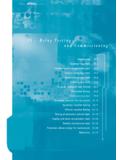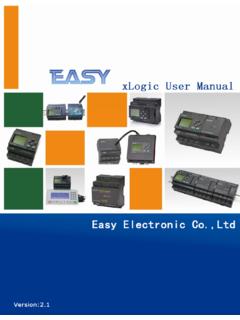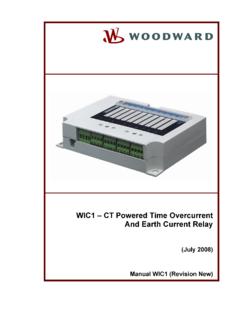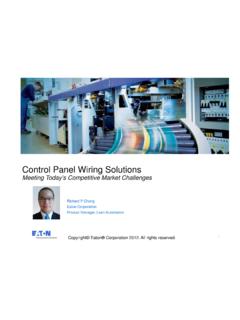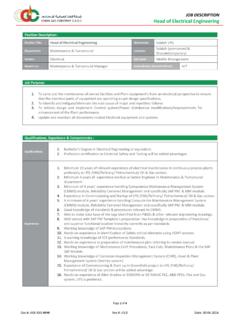Transcription of 269 Plus - Eaton
1 Instruction ManualFirmware Rev.: P/N: 1601-0013-D3 Copyright 1999 GE MultilinCANADA215 Anderson Avenue, Markham, Ont., L6E 1B3 Tel. (905) 294-6222 Fax. (905) 294-8512 Interne t: htt p:// .com/ed c/pm269 PlusMOTOR MANAGEMENT RELAY TABLE OF CONTENTSi1 Motor Protection 269 plus Relay Features .. Typical Applications .. Order Technical Specifications .. 1-62 Physical Dimensions .. Mounting .. External Connections .. Control Phase CT Inputs .. Ground CT Input .. Trip Relay Contacts .. Alarm Relay Auxiliary Relay #1 Contacts .. Auxiliary Relay #2 Contacts .. RTD Sensor Emergency Restart Terminals .. External Reset Terminals .. Analog Output Terminals (Non-Isolated) Differential Relay Terminals.
2 Speed Switch Terminals .. Programming Access Terminals .. RS-485 Serial Display Front Panel Faceplate .. Spare Input Terminals .. 269 plus Drawout Relay .. Meter Option Installation .. 2-253 SETUP AND Controls and Indicators .. 269 plus Relay Display ACTUAL VALUES Mode .. Starts/Hour Timer .. Time Between Starts Timer .. Cause of Last Cause of Last Event .. SETPOINTS Mode .. HELP Mode .. TRIP/ALARM Mode .. Phase CT and Motor Full Load CurrentSetpoints .. Acceleration Time Setpoint .. Unbalance Setpoints .. Ground Fault (Earth Leakage)Setpoints .. Undercurrent Setpoints .. Rapid Trip / Mechanical Jam Setpoints . Short Circuit Setpoints.
3 Immediate Overload Alarm LevelSetpoint .. Stator RTD Setpoints .. Other RTD Setpoints .. Overload Curve Setpoints .. Thermal Capacity Thermal Memory .. Emergency Restart .. Resetting The 269 plus Relay .. 269 plus Relay Self-Test .. Statistical Data Features .. Factory Setpoints .. Meter Option .. 3-664 Modes of Physical Layer .. Packet Format .. The Handshake .. Supported Functions .. Exception or Error Replies .. Error Checking CRC-16 A Sample Packet with CRC-16 .. Memory Map .. 4-55 Primary Injection Testing .. Secondary Injection Testing .. Phase Current Input Functions .. Ground Fault Current Functions .. RTD Measurement Tests.
4 Power Failure Testing .. Analog Current Output .. Routine Maintenance Verification .. Dielectric Strength (Hi-Pot) Test .. 5-56 THEORY OF Firmware .. 6-17 APPLICATION 269 plus Relay Powered from One of MotorPhase Inputs .. Loss of Control Power Due to Short Circuit orGround Fault .. Example Using FLC Thermal CapacityReduction 7-18 269PC Overview .. Hardware and Software Requirements .. Menu Summary .. Hardware Configuration .. 269 PC Installation .. Startup and Entering Saving Setpoints to a File .. Loading Setpoints From a File .. 8-12 TABLE OF CONTENTS Viewing Actual Values .. 8-16 APPENDIX A269 plus UNBALANCE EXAMPLE .. A-1 APPENDIX B269 plus Thermal Model.
5 B-1269 plus RTD Bias B-2 APPENDIX C269 plus RTD D2I CT Configuration ..D-1 APPENDIX EAsymmetrical Starting Current .. E-1 APPENDIX F269 plus Do's and Don'ts F-1 APPENDIX GGround Fault and Short Circuit InstantaneousElements .. G-1 APPENDIX HI. 269 plus CT CT Size and Saturation ..H-1 APPENDIX I269 plus Commissioning Summary .. I-1 GLOSSARY1 Motor Protection RequirementsThree phase motors have become standard inmodern industry. These motors are generally ruggedand very reliable when used within their rated motors, however, tend to be designed to runmuch closer to these operational limits and thus, thereis less margin available for any type of abnormal sup-ply, load, or operating order to fully protect these motors, a modern protec-tive device is required.
6 Accurate stator and rotor ther-mal modeling is necessary to allow the motor tooperate within its thermal limits and still give the maxi-mum desired output. As well, other features can beincorporated into a modern relay to fully protect themotor, the associated mechanical system, and themotor operator from all types of faults or thermal limits can be exceeded due to increasedcurrent from mechanical overloads or supply unbal-ance. Unbalance can greatly increase heating in therotor because of the large negative sequence currentcomponents present during even small voltage unbal-ances. A locked or stalled rotor can cause severeheating because of the associated large currents drawnfrom the supply.
7 Many motor starts over a short periodof time can cause overheating as well. Phase-to-phaseand phase-to-ground faults can also cause damage tomotors and hazards to personnel. Bearing overheatingand loss of load can cause damage to the mechanicalload being driven by the ideal motor protection relay should monitor therotor and stator winding temperatures exactly and shutoff the motor when thermal limits are reached. Thisrelay should have an exact knowledge of the tempera-ture and proper operating characteristics of the motorand should shut down the motor on the occurrence ofany potentially damaging or hazardous GE Multilin Model 269 plus Motor ManagementRelay uses motor phase current readings combinedwith stator RTD temperature readings to thermallymodel the motor being protected.
8 In addition, the 269 plus takes into account the heating effects of negativesequence currents in the rotor, and calculates thecooling times of the motor. The relay also monitors themotor and mechanical load for faults and the addition of a GE Multilin meter (MPM), the269 plus may also monitor voltages and power andperform several protection functions based on 269 plus Relay FeaturesThe GE Multilin Model 269 plus Motor ManagementRelay is a modern microcomputer-based product de-signed to provide complete, accurate protection forindustrial motors and their associated mechanical sys-tems. The 269 plus offers a wide range of protection,monitoring, and diagnostic features in a single, inte-grated package.
9 All of the relay setpoints may be pro-grammed in the field using a simple 12 position keypadand 48 character alphanumeric display. A built-in"HELP" function can instruct the user on the properfunction of each of the programming keys and on themeaning of each displayed 269 plus relay is required per motor. Phase andground fault currents are monitored through currenttransformers so that motors of any line voltage can beprotected. The relay is used as a pilot device to causea contactor or breaker to open under fault conditions;that is, it does not carry the primary motor model 269 plus incorporates the following fea-tures: custom curve selectability, motor statistical rec-ords, speed switch input, differential relay input, 10 RTD inputs, single shot emergency restart feature, anRS485 communications port, unbalance input to ther-mal memory, start inhibit feature, and spare custom curve feature of the model 269 plus givesthe user additional flexibility.
10 If one of the eight stan-dard overload curves is not suitable for the applicationunder consideration, the user can enter his own break-points to form a custom curve. This means that the269 plus can offer optimum motor protection in situa-tions where other relays cannot. Such applicationsinclude induced fan drives where the motor stator androtor thermal capacities can differ important feature of the GE Multilin 269 plus relay,is its ability to "learn" individual motor parameters. Therelay actually adapts itself to each application by"learning" values of motor inrush current, negative se-quence current K factor, cool down rates, and accel-eration time.










